The Cincinnati Kid Blu-ray Movie
HomeThe Cincinnati Kid Blu-ray Movie 
Warner Bros. | 1965 | 103 min | Not rated | Jun 14, 2011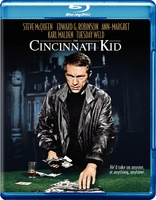
Movie rating
7.2 | / 10 |
Blu-ray rating
| Users | 3.5 | |
| Reviewer | 3.5 | |
| Overall | 3.5 |
Overview
The Cincinnati Kid (1965)
A professional poker player, with a "can't lose" reputation, is challenged to a game by another infamous rival.
Starring: Steve McQueen (I), Edward G. Robinson, Ann-Margret, Karl Malden, Tuesday WeldDirector: Norman Jewison
| Drama | 100% |
Specifications
Video
Video codec: MPEG-4 AVC
Video resolution: 1080p
Aspect ratio: 1.78:1
Original aspect ratio: 1.85:1
Audio
English: DTS-HD Master Audio Mono (48kHz, 24-bit)
French: Dolby Digital Mono
Spanish: Dolby Digital Mono
German: Dolby Digital Mono
Portuguese: Dolby Digital Mono
Subtitles
English SDH, French, German SDH, Portuguese, Spanish, Danish, Finnish, Norwegian, Swedish
Discs
25GB Blu-ray Disc
Single disc (1 BD)
Playback
Region free
Review
Rating summary
| Movie | 3.5 | |
| Video | 4.5 | |
| Audio | 3.5 | |
| Extras | 3.0 | |
| Overall | 3.5 |
The Cincinnati Kid Blu-ray Movie Review
Do the hustle.
Reviewed by Jeffrey Kauffman June 5, 2011When is a hustler not a hustler? When the hustler is The Cincinnati Kid and not The Hustler. It’s a little ironic that The Cincinnati Kid is now following in The Hustler’s fairly recent footsteps by debuting on Blu-ray, as the two films have often been compared, and usually to The Cincinnati Kid’s detriment. Both films deal with ambitious “youngsters” who are out to prove their mettle in vicious tournament exhibitions. In The Hustler’s case, that’s pool. With The Cincinnati Kid, we’re in the world of poker. But both films are fairly remarkably alike in terms of overall tone, if not exactly similar in content. The two films also stand as important highlights in their lead actors’ careers. While Paul Newman and Steve McQueen had both cut their teeth in 1950’s television, Newman was a bit quicker to matriculate to big screen stardom (though McQueen actually had his first screen role before Newman did), and by the time The Hustler made it to Cineplexes in 1961, he was already well on his way to being that decade’s leading male attraction. (Look for McQueen in a bit part in the Newman starrer Somebody Up There Likes Me, made almost two decades before the two would co-star in The Towering Inferno). McQueen had had a somewhat tougher road to hoe, and was still establishing his film bona fides when The Cincinnati Kid debuted in 1965, despite having had one of his most iconic roles relatively recently with 1963’s The Great Escape. Perhaps the somewhat ambiguous response to McQueen’s screen persona, at least with regard to the reaction given to Newman, is that McQueen was a “pricklier” screen presence and harder to picture in a traditional outright heroic role. Even The Great Escape showed McQueen’s “good guy” colored with some dark undertones. That selfsame coloring was certainly in evidence in a lot of Newman’s portrayals, especially in The Hustler where it was actually a bit shocking, but Newman also had a breezy, light quality at times, notably in his romantic comedies, that McQueen never was able to successfully carry off. But that very darkness served McQueen quite well in The Cincinnati Kid, a Depression era “poker shark” who, just like Newman’s Hustler character, is out to take down the reigning champion and prove that he’s the new Big Man on Campus.
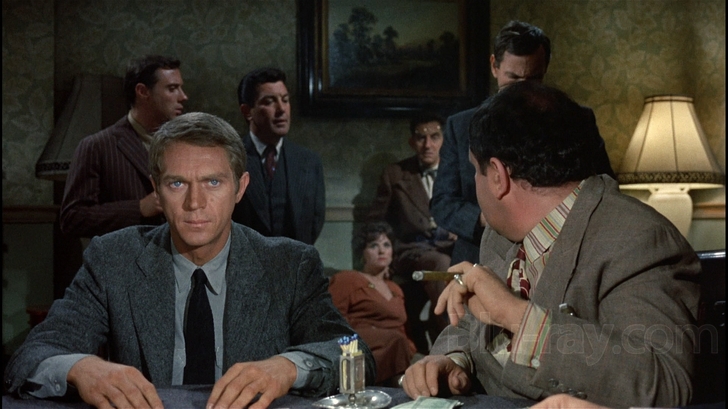
McQueen portrays Eric “The Kid” Stoner, an up and coming poker player who wants to take on Lancey “The Man” Howard (Edward G. Robinson). The fact that we have “The Kid” up against “The Man” is indicative of the sort of shorthand that Ring Lardner, Jr. and Terry Southern’s adaptation of Richard Jessup’s novel offers, reducing characters to types. Add in the fact that The Kid’s virginal girlfriend is named Christian (Tuesday Weld), a blowsy dealer is named Lady Fingers (Joan Blondell), and a sweaty competitor goes by the handle Pig (Jack Weston), and you start to get the idea of how this film presents its “kitchen sink” realities with a large placard proclaiming “Kitchen Sink.” And while this aspect of The Cincinnati Kid is lamentable, perhaps even laughable, it’s to the film’s (as well as director Norman Jewison’s) credit that the actors rise above the silliness to deliver some bristlingly effective performances.
This was in fact the film where Jewison was able to shake off the lightweight romantic comedies that had defined the opening play (to borrow an appropriate term) of his film career (40 Pounds of Trouble, The Thrill of It All, Send Me No Flowers, The Art of Love). You can see Jewison feeling his way with this film into the solid dramatic flow that would characterize his mature films like In the Heat of the Night, but there are still stumbles in The Cincinnati Kid. As with his later films, the best thing about Cincinnati is the uniformly excellent work by the ensemble, which also includes great turns by Ann-Margret as the straying wife of a conflicted dealer played by Karl Malden. Where the film never really connects is in its supposed depiction of a sordid, dissolute ambience, and in that regard it’s decidedly inferior to Richard Rossen’s commanding work in The Hustler. Part of this failure might be attributed to what probably seemed a fairly innocuous choice by Jewison, namely to film The Cincinnati Kid in color. Despite Jewison's insistence that that choice was necessary due to the different colored cards being used (a debatable issue), black and white might have given this film the gritty ambience that so infused The Hustler. In fact original director Sam Peckinpah, who was fired two weeks into the filming, had wanted to make the film in black and white and his footage was indeed filmed that way (Jewison refilmed everything, so the final film is all in color).
Also hampering the film (especially with regard to comparing it to The Hustler) is its very subject matter. The Hustler at least depicted men in motion, with a “sport” that includes trick shots and other aspects that allow at least some visual interest. Poker after all is a rather sedentary activity, and furthermore it’s marked by a complete lack of affect that has entered the public lexicon with the term “poker face.” That leaves Jewison dramatically high and dry at times, as he attempts to invest the film with suspense and drama when the actors are stone-faced and attempting to bluff their way into riches. It’s an odd dynamic and one from which The Cincinnati Kid can never successfully build any completely effective impact. Jewison evidently brought Terry Southern into the project to lighten up what Jewison himself felt was a too "turgid" apporach by Lardner, but those results are also mixed. After one of the greatest character introductions in history with regard to Ann-Margret's Melba (pay close attention to what she's doing), the screenplay throws it all away with some Dynasty level dialogue about constant cheating that not even the great Karl Malden can pull off.
The improbability of the climactic hand has been the subject of much speculation and discourse through the years, something that adds to the unreality of the film. (For a good laugh, mosey over to the Wikipedia entry for The Cincinnati Kid and read some mathematician’s philosophical defense of what probability really means within the confines of any particular poker hand). By that time, though, The Kid has devolved into the moral equivalent of pudding, and there’s such an unseemly undercurrent to the final third of the film that few will be lamenting or celebrating the eventual victor and loser of the big showdown.
The Cincinnati Kid is best appreciated as a transitional film of sorts for several cast and crew members. For scenarist Ring Lardner, Jr., it was a return to a career that had been sadly truncated by the House Unamerican Activities Committee and the blacklist. For Jewison, it was his first foray into turgid dramatics, especially those colored with the Gothic atmosphere of the American south, where he would later make one of his most iconic films. For McQueen, it was one of his first non-action dramatic roles where he could prove he could carry a film. For Ann-Margret and Tuesday Weld, The Cincinnati Kid gave them the chance to show they were a lot more than just pretty faces. And for three stars of former years (interestingly two of them with strong Warner pedigrees), Edward G. Robinson, Joan Blondell and Karl Malden, the film was an excellent opportunity for career defining character work allowing them to show that increasing age needn’t necessarily spell the demise of their livelihoods. While the film itself is a mixed bag, for each of these individuals The Cincinnati Kid proved to be an important stepping stone. The main problem with The Cincinnati Kid is in fact that it will probably always be compared, rightly or wrongly, to The Hustler and is fated to be “always second-best,” to quote The Man’s assessment of The Kid.
The Cincinnati Kid Blu-ray Movie, Video Quality 
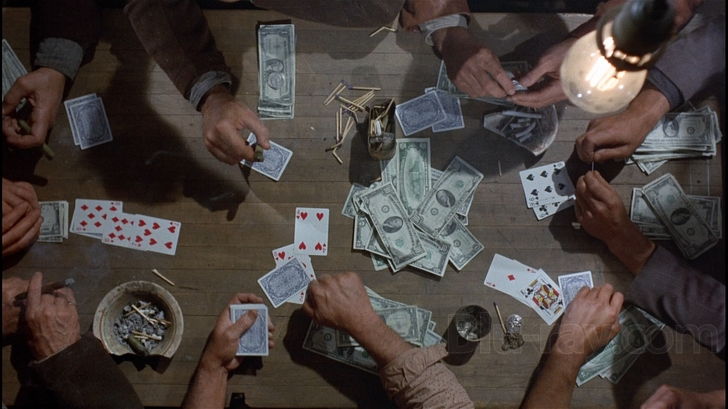
The Cincinnati Kid looks a little flushed (sorry, couldn't resist) in its Blu-ray debut. Encoded via AVC in 1080p and 1.78:1, the film looks really incredibly sharp and vivid but it can't disguise the often lurid tones of Metrocolor, MGM's preferred technology in those days. It's especially funny to hear Jewison in his commentary opining about the "muted tones" of his Depression Era film, and the subsequent lack of "bright reds" at the exact moment a fiery orange-red umbrella bursts into frame. The luridness actually extends mostly to the green end of the spectrum, making some of the foliage look slightly unreal. On the whole, though, the film's palette is accurate looking, at least within the confines of Metrocolor, and the image itself is wonderfully clear and precise. Fine detail is excellent, there doesn't appear to have been any aggressive DNR applied to this release, and this is yet another really solid catalog release by Warner, who continues to do (mostly) laudable work with their older films.
The Cincinnati Kid Blu-ray Movie, Audio Quality 
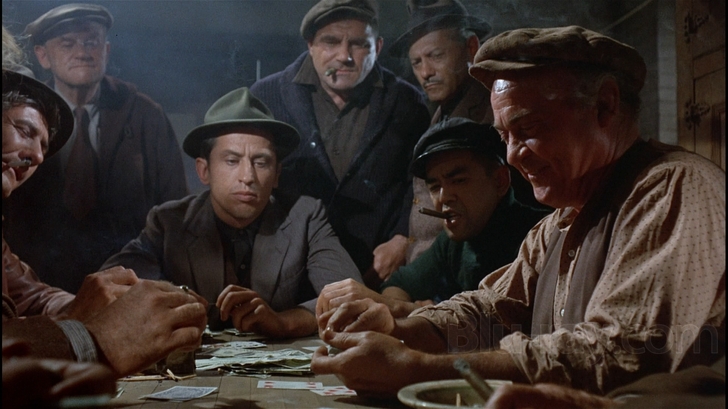
The Cincinnati Kid doesn't have a faux lossless surround mix, and that's probably a good thing. The only English language track is a DTS-HD Master Audio mono mix that certainly suffices for the films more modest, dialogue driven aims. While it might have been nice to have heard Lalo Schifrin's great score and the equally nice Ray Charles closing theme in a repurposed 5.1 mix, otherwise this film really doesn't present all that many opportunities for a sonic "wow" factor. Fidelity here is just fine, with a certain narrowness and boxiness redolent of the film's era, but certainly no egregious damage or even hiss to report. This isn't going to set anyone's heart on fire, but the soundtrack gets the job done with a minimum of fuss and bother.
The Cincinnati Kid Blu-ray Movie, Special Features and Extras 
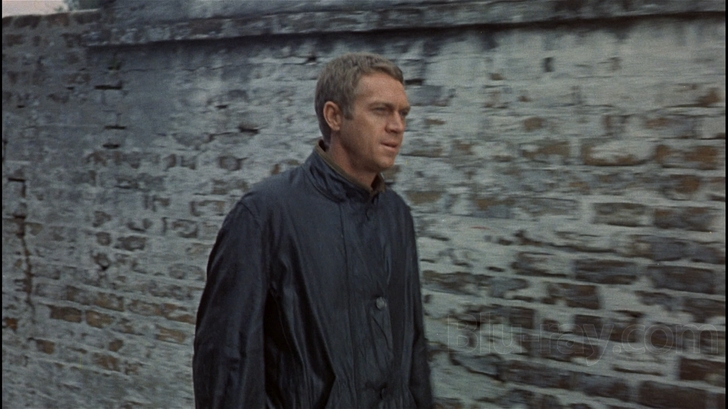
- Commentary by Director Norman Jewison. Jewison always contributes enjoyable commentaries to his features, and The Cincinnati Kid is no exception. While some of the stylistic choices he commends the film for—like being in color—are at least arguable, Jewison does a really entertaining job outlining the background of the project, being brought in at the last minute to replace the fired Sam Peckinpah, and working with an iconic cast, many of whom were young and relatively untested. Jewison also laments that this release features a tacked on ending which doesn't match how he wanted the film to end.
- Scene Specific Commentary by Celebrity Poker Showdown Hosts Phil Gordon and Dave Foley. A good deal sillier (and chattier, despite long pauses) is this commentary which supposedly features on the poker elements of the film but which has a tendency to veer into uncharted territory at least a time or two due to Foley's outré sense of humor.
- The Cincinnati Kid Plays According to Hoyle (SD; 6:15). This vintage featurette (in black and white) shows card shark Jay Ose "training" Joan Blondell on technique. The funny thing is, as you'll learn from Jewison's commentary, Blondell was so unsure of her card handling prowess that they actually made up Ose's hands (replete with pink-orange nail polish) for close-up inserts of shuffling, cutting and dealing used in the final cut of the film.
- Theatrical Trailer
The Cincinnati Kid Blu-ray Movie, Overall Score and Recommendation 
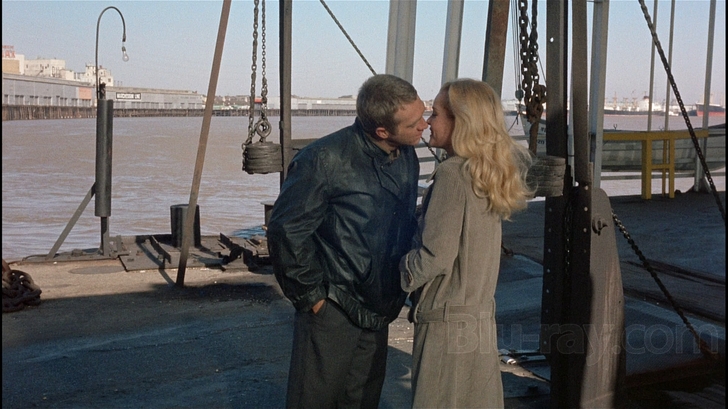
It may not be The Hustler, but The Cincinnati Kid has its own distinctive pleasures, headed by uniformly excellent work from a really remarkable cast. The screenplay is a little clunky some of the time, but Jewison and his actors manage to rise above those elements to deliver an interesting character study. There may not be a lot of nuance in The Cincinnati Kid, but there's an incredible amount of energy. This Blu-ray looks and sounds great, and is Recommended.
Similar titles
Similar titles you might also like

Wildlife
2018

Grand Hotel
1932

J. Edgar
2011

Hamlet
1948

The Servant
1963

Good
2008

Little Caesar
1931

American Pastoral
2016

Salome
1953

Hamlet
2009

King of the Hill
1993

All About Eve
60th Anniversary
1950

All the King's Men
2006

Modern Times
1936

The Miami Story
1954

House of Cards Trilogy
House of Cards / To Play the King / The Final Cut
1990-1995

A King in New York
1957

Her Smell
2018

Cymbeline
2014

The Crusades
1935